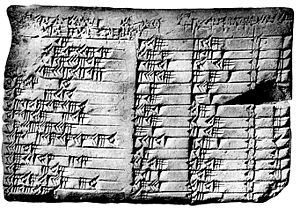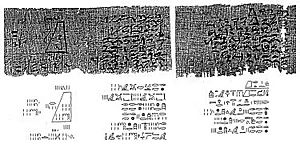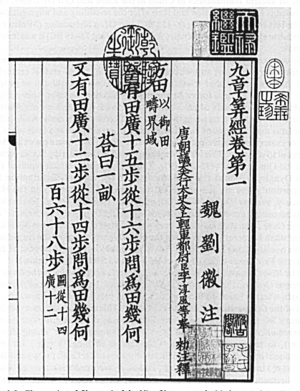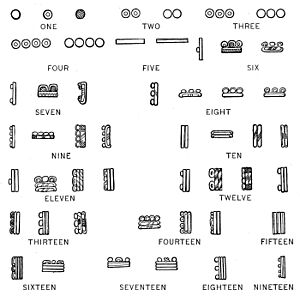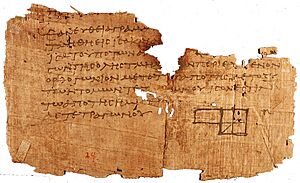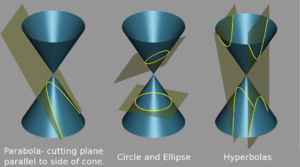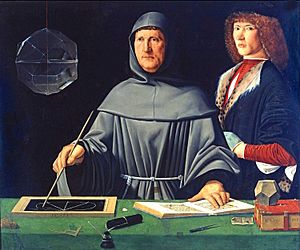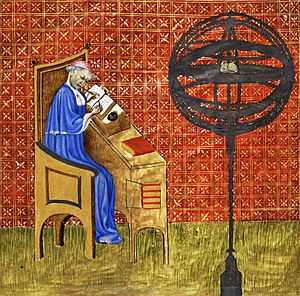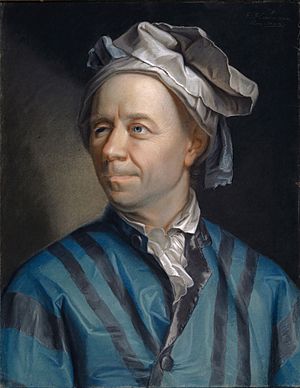History of mathematics facts for kids
The History of mathematics is all about how mathematics has grown and changed over many thousands of years. It's a story of amazing discoveries and clever thinkers from different parts of the world.
Early math ideas came from ancient civilizations like the Babylonians and Egyptians. They used math for things like building pyramids, tracking time, and managing their farms. Later, brilliant thinkers from ancient Greece, such as Euclid, Archimedes, Pythagoras, and Eratosthenes, built on these ideas and added many new ones.
Over time, other important people like Fibonacci, Descartes, Leonhard Euler, Blaise Pascal, and Gauss made huge contributions that shaped the math we know today.
Contents
Ancient Roots of Mathematics
Mathematics started long, long ago, even before writing was invented. People needed ways to count things like animals, food, or days. They used simple methods, like making marks on bones or tying knots in ropes.
Counting and Early Numbers
The very first math was probably about counting. People needed to know how many things they had. This led to the idea of numbers. Different cultures developed their own ways of writing and using numbers.
Babylonian and Egyptian Math
The ancient Babylonians, who lived in what is now Iraq, were very good at math. They used a number system based on 60, which is why we have 60 seconds in a minute and 360 degrees in a circle! They solved complex problems, including some types of algebra.
The ancient Egyptians also used math for practical reasons. They needed it to build their massive pyramids and temples, measure land after the Nile River flooded, and create their calendar. They had a system for fractions and could solve simple equations.
Math in Ancient China
Ancient China also had a rich history of mathematics. They developed a decimal system, which is the base-10 system we use today. They also created early versions of the abacus for calculations.
One of the most important Chinese math books is The Nine Chapters on the Mathematical Art. It covers many topics, including fractions, areas, and solving equations.
Indian Mathematics
India made huge contributions to math, especially with the invention of the number zero and the decimal place value system. This system, which uses digits 0-9 and the idea that a digit's position matters (like in 123, the '1' means 100), is the foundation of modern arithmetic.
Maya Mathematics
The Maya civilization in Central America developed a unique number system. It was a base-20 system and included a symbol for zero, which was very advanced for their time. They used their math skills to create incredibly accurate calendars and astronomical observations.
Greek Contributions to Mathematics
Ancient Greece is often called the birthplace of modern mathematics because of its focus on logic and proofs. Greek mathematicians didn't just find answers; they wanted to prove why those answers were correct.
Famous Greek Mathematicians
- Pythagoras (around 570–495 BC) is famous for the Pythagorean theorem, which describes the relationship between the sides of a right-angled triangle.
- Euclid (around 300 BC) wrote Elements, one of the most influential math textbooks ever. It organized all the geometry knowledge of his time and is still studied today.
- Archimedes (around 287–212 BC) was a brilliant inventor and mathematician. He discovered important principles about density and buoyancy (why things float) and made advances in calculating areas and volumes.
- Apollonius of Perga (around 262–190 BC) studied conic sections (shapes like circles, ellipses, parabolas, and hyperbolas) in great detail. His work was crucial for understanding how planets move.
Mathematics in the Islamic Golden Age
After the fall of the Roman Empire, many mathematical ideas were preserved and expanded in the Islamic world. Scholars translated Greek and Indian texts and made their own significant discoveries.
Key Islamic Mathematicians
- Muhammad ibn Mūsā al-Khwārizmī (around AD 780–850) was a Persian mathematician whose work was incredibly important. He wrote a book called The Compendious Book on Calculation by Completion and Balancing, which gave us the word "algebra" (from the Arabic word "al-jabr"). He also helped spread the Indian decimal number system to the West.
- Many Islamic mathematicians also excelled in trigonometry, which is the study of triangles and their angles, used in astronomy and navigation.
Mathematics in Medieval Europe
For a long time, math in Europe was not as advanced as in other parts of the world. However, during the Middle Ages, new ideas started to arrive, often from the Islamic world.
Fibonacci and the Spread of Numbers
Leonardo Fibonacci (around 1175–1250) was an Italian mathematician who traveled widely. He learned about the Hindu-Arabic numeral system (the 0-9 system) and wrote a book called Liber Abaci (Book of Calculation) in 1202. This book helped introduce the decimal system to Europe, slowly replacing the older Roman numerals. He is also famous for the Fibonacci sequence, a pattern of numbers where each number is the sum of the two before it (0, 1, 1, 2, 3, 5, 8...).
Nicole Oresme and Early Graphs
Nicole Oresme (1323–1382) was a French philosopher and mathematician. He was one of the first to use a system similar to coordinates to graph relationships, which was a very early step towards what we now call coordinate geometry.
The Renaissance and Modern Mathematics
The Renaissance was a time of great change and discovery in Europe, and mathematics flourished. New tools and ideas led to rapid advancements.
Descartes and Coordinate Geometry
René Descartes (1596–1650) was a French philosopher and mathematician. He invented coordinate geometry, which links algebra and geometry. This means you can describe geometric shapes using equations and visualize algebraic equations as graphs. This was a huge step forward and is fundamental to much of modern math and science.
Calculus: Newton and Leibniz
One of the biggest breakthroughs was the development of calculus in the late 17th century. Calculus is a powerful tool for understanding change and motion.
- Isaac Newton (1642–1727) in England and Gottfried Wilhelm Leibniz (1646–1716) in Germany independently developed calculus around the same time. They had different ways of writing it, but their ideas were similar. Calculus is essential for physics, engineering, and many other fields.
The Age of Great Mathematicians
The 18th and 19th centuries saw many brilliant mathematicians who expanded on earlier ideas and created entirely new branches of math.
Leonhard Euler
Leonhard Euler (1707–1783) was a Swiss mathematician who made countless contributions to almost every area of mathematics. He introduced much of the modern mathematical notation we use today, like the symbol for pi (π) and the letter 'e' for the base of natural logarithms. He worked on calculus, number theory, and graph theory.
Carl Friedrich Gauss
Carl Friedrich Gauss (1777–1855) was a German mathematician often called the "Prince of Mathematicians." He made fundamental contributions to number theory, algebra, statistics, and geometry. His work was so important that it influenced many areas of science and engineering.
Mathematics Today
Today, mathematics continues to grow and evolve. Computers and technology have opened up new ways to explore complex problems. Math is used in almost every field, from designing video games and predicting weather to developing new medicines and understanding the universe. The history of mathematics is a story of human curiosity and the endless quest to understand the world through numbers and logic.
Images for kids
-
The Hagia Sophia was designed by mathematicians Anthemius of Tralles and Isidore of Miletus.
-
Equipment used by an ancient Roman land surveyor (gromatici), found at the site of Aquincum, modern Budapest, Hungary.
-
Title page of the 1621 edition of Diophantus' Arithmetica, translated into Latin.
-
The absolute value of the Gamma function on the complex plane.
See also
 In Spanish: Historia de las matemáticas para niños
In Spanish: Historia de las matemáticas para niños


